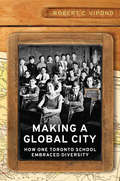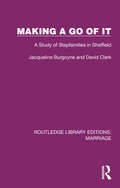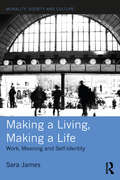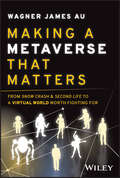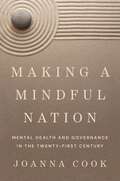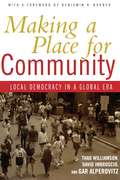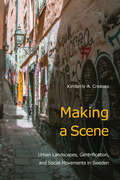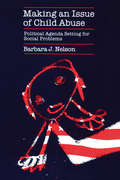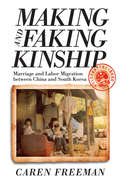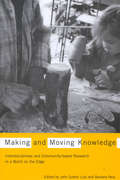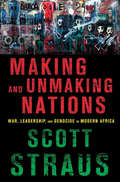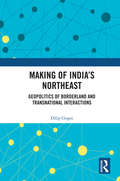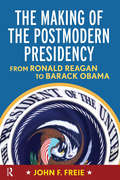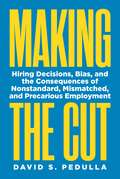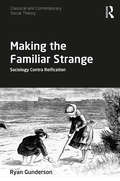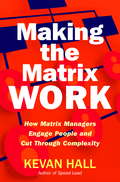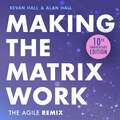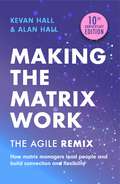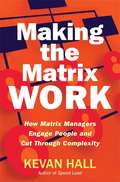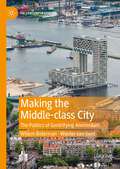- Table View
- List View
Making a Global City: How One Toronto School Embraced Diversity
by Robert VipondHalf of Toronto’s population is born outside of Canada and over 140 languages are spoken on the city's streets and in its homes. How to build community amidst such diversity is one of the global challenges that Canada – and many other western nations – has to face head on. Making a Global City critically examines the themes of diversity and community in a single primary school, the Clinton Street Public School in Toronto, between 1920 and 1990. From the swift and seismic shift from a Jewish to southern European demographic in the 1950s to the gradual globalized community starting in the 1970s, Vipond eloquently and clearly highlights the challenges posed by multicultural citizenship in a city that was dominated by Anglo-Protestants. Contrary to recent well-documented anti-immigrant rhetoric in the media, Making a Global City celebrates one of the world’s most multicultural cities while stressing the fact that public schools are a vital tool in integrating and accepting immigrants and children in liberal democracies.
Making a Go of It: A Study of Stepfamilies in Sheffield (Routledge Library Editions: Marriage)
by David Clark Jacqueline BurgoyneOriginally published in 1984, Making a Go of It presents findings from a study of remarried couples in Sheffield between 1976 and 1979. Including case studies from the families involved, it also discusses marriage as a social institution and some of the main theoretical and methodological issues which bear upon the study of family and domestic life. It was hoped that the book would be interesting and accessible to remarried couples themselves as well as to members of those occupations who have a ‘professional’ interest in families of all kinds. Still a useful resource, today it can be read and enjoyed in its historical context.
Making a Good Life: An Ethnography of Nature, Ethics, and Reproduction
by Katharine DowMaking a Good Life takes a timely look at the ideas and values that inform how people think about reproduction and assisted reproductive technologies. In an era of heightened scrutiny about parenting and reproduction, fears about environmental degradation, and the rise of the biotechnology industry, Katharine Dow delves into the reproductive ethics of those who do not have a personal stake in assisted reproductive technologies, but who are building lives inspired and influenced by environmentalism and concerns about the natural world's future.Moving away from experiences of infertility treatments tied to the clinic and laboratory, Dow instead explores reproduction and assisted reproductive technologies as topics of public concern and debate, and she examines how people living in a coastal village in rural Scotland make ethical decisions and judgments about these matters. In particular, Dow engages with people's ideas about nature and naturalness, and how these relate to views about parenting and building stable environments for future generations. Taking into account the ways daily responsibilities and commitments are balanced with moral values, Dow suggests there is still much to uncover about reproductive ethics. Analyzing how ideas about reproduction intersect with wider ethical struggles, Making a Good Life offers a new approach to researching, thinking, and writing about nature, ethics, and reproduction.
Making a Life: Young Men on Johannesburg’s Urban Margins
by Hannah J DawsonMaking a Life explores the dynamic everyday life-making strategies of young men in Zandspruit, a sprawling informal settlement on the outskirts of Johannesburg. In many ways Zandspruit typifies the precariousness of life within South Africa, where two-thirds of young people lack waged employment. However, rather than seeing Zandspruit as dumping ground, Hannah Dawson calls for an integrated understanding of the complex linkages between people’s lives and livelihoods, and the multifaceted socio-political landscape of urban settlements. Based on 14 months of ethnographic research, Dawson investigates how social belonging, identity and economic realities intertwine in places such as Zandspruit. This approach not only challenges conventional approaches to studying work; it also questions the increasingly prevalent perspective that romanticises the adaptive survival strategies of the urban poor. By exploring the intricate connections between those with and without wages, the author shows how young men manage complex social, political and economic conditions. Making a Life offers insights into issues such as urban work, citizenship, un(der)employment and inequality in South Africa. At the same time, it contributes to a global understanding of how young people – men especially – manage economic uncertainty.
Making a Living, Making a Life: Work, Meaning and Self-Identity (Morality, Society and Culture)
by Sara JamesIn a world in which individuals will undergo multiple career changes, is it possible any longer to conceive of a job as a meaningful vocation? Against the background of fragmentation and rationalisation of work, this book explores the significance and meaning of work in contemporary life, raising the question of whether people continue to feel motivated to dedicate their lives to their work, or must now look to other areas of life for meaning. Based on rich, in-depth interviews conducted with workers of different ages and across a broad range of occupations in the major city of Melbourne, Making a Living, Making a Life reveals that work continues to be a source of pride, passion and purpose, the author shedding light on the ways in which cultural narratives, collective meanings and structural factors influence people’s feelings about work. An engaging and empirically grounded examination of the meaning and centrality of work to people’s lives in today’s 'liquid' modern world, this book will appeal to sociologists with interests in cultural sociology, social theory, ethics, the sociology of work and questions of identity.
Making a Metaverse That Matters: From Snow Crash & Second Life to A Virtual World Worth Fighting For
by Wagner James AuAn up-close account from the world’s first metaverse-embedded reporter In Making a Metaverse That Matters: From Snow Crash & Second Life to A Virtual World Worth Fighting For, the celebrated author of The Making of Second Life and Game Design Secrets, Wagner James Au, delivers an engrossing exploration of how nascent metaverse platforms have already captured the imagination of millions. Featuring powerful stories and dozens of incisive interviews with insiders including Metaverse creator Neal Stephenson himself, the author uses his unique, grassroots-level perspective as the first reporter embedded in a metaverse platform. Readers will learn about: How to understand and define the Metaverse and cut through the many myths and misconceptions around it. A behind-the-scenes account of launching Second Life, the first metaverse platform to achieve mainstream awareness, and what its many controversies teach us. Where current platforms Meta, Roblox, Fortnite, VRChat, and Lamina1, Neal Stephenson’s own metaverse startup, fit in the ecosystem. How to address the many dangers inherent in the Metaverse before it becomes central to the Internet. Perfect for XR industry members and indie creatives, Making a Metaverse That Matters is also for tech professionals, virtual world communities, and anyone interested in the future of culture and commerce.
Making a Mindful Nation: Mental Health and Governance in the Twenty-First Century
by Joanna CookHow mindfulness came to be regarded as a psychological support, an ethical practice and a component of public policyMindfulness seems to be everywhere—in popular culture, in therapeutic practice, even in policy discussions. How did mindfulness, an awareness training practice with roots in Buddhism, come to be viewed as a solution to problems that range from depression and anxiety to criminal recidivism? If mindfulness is the answer, asks Joanna Cook, what is the question? In Making a Mindful Nation, Cook uses the lens of mindfulness to show how cultivating a relationship with the mind is now central to the ways people envision mental health. Drawing on long-term fieldwork with patients, therapists, members of Parliament and political advocates in Britain, Cook explores how the logics of preventive mental healthcare are incorporated into people’s relationships with themselves, therapeutic interventions, structures of governance and political campaigns.Cook observed mindfulness courses for people suffering from recurrent depression and anxiety, postgraduate courses for mindfulness-based therapists, parliamentarians’ mindfulness practice and political advocacy for mindfulness in public policy. She develops her theoretical argument through intimate and in-depth stories about people’s lives and their efforts to navigate the world—whether these involve struggles with mental health or contributions to evolving political agendas. In doing so, Cook offers important insights into the social processes by which mental health is lived, the normative values that inform it and the practices of self-cultivation by which it is addressed.
Making a Place for Community: Local Democracy in a Global Era
by Gar Alperovitz Thad Williamson David ImbroscioWhen pundits refer to the death of community, they are speaking of a number of social ills, which include, but are not limited to, the general increase in isolation and cynicism of our citizens, widespread concerns about declining political participation and membership in civic organizations, and periodic outbursts of small town violence. Making a Place for Community argues that this death of community is being caused by contemporary policies that, if not changed, will continue to foster the decline of community. Increased capital flow between nations is not at the root of the problem, however, increased capital flow within our nation is. Small towns shouldn't have to hope for a prison to open nearby and downtown centers shouldn't sit empty as suburban sparwl encroaches, but they do and it's a result of widely agreed upon public policies.
Making a Scene: Urban Landscapes, Gentrification, and Social Movements in Sweden
by Kimberly A. CreasapIn the three largest cities in Sweden, social movement “scenes”—networks of social movement actors and the places they inhabit—challenge threats such as gentrification. The geography of the built environment influences their ability to lay claim to urban space and to local political processes. In Making a Scene, Kimberly Creasap emphasizes that it is the centrality, concentration, and visibility of these scenes that make them most effective. Whereas some scenes become embedded as part of everyday life—as in Malmö—in contrast, scenes in Göteborg and Stockholm often fail to become part of the fabric of urban neighborhoods. Creasap investigates key spaces for scenes, from abandoned industrial areas and punk clubs to street festivals, bookstores, and social centers, to show how activists create sites and develop structures of resistance that are anti-capitalist, anti-fascist, anti-gentrification, queer, and feminist. She also charts the relationship between scenes and city spaces to show these autonomous social movements create their own cultural landscapes. Making a Scene encourages critical thinking about spatiality and place in the sociology of social movements and the role of social movements as important actors in urban development.
Making an Issue of Child Abuse: Political Agenda Setting for Social Problems
by Barbara J. NelsonIn this absorbing story of how child abuse grew from a small, private-sector charity concern into a multimillion-dollar social welfare issue, Barbara Nelson provides important new perspectives on the process of public agenda setting. Using extensive personal interviews and detailed archival research, she reconstructs an invaluable history of child abuse policy in America. She shows how the mass media presented child abuse to the public, how government agencies acted and interacted, and how state and national legislatures were spurred to strong action on this issue. Nelson examines prevailing theories about agenda setting and introduces a new conceptual framework for understanding how a social issue becomes part of the public agenda. This issue of child abuse, she argues, clearly reveals the scope and limitations of social change initiated through interest-group politics. Unfortunately, the process that transforms an issue into a popular cause, Nelson concludes, brings about programs that ultimately address only the symptoms and not the roots of such social problems.
Making and Faking Kinship: Marriage and Labor Migration between China and South Korea
by Caren FreemanIn the years leading up to and directly following rapprochement with China in 1992, the South Korean government looked to ethnic Korean (Chosǒnjok) brides and laborers from northeastern China to restore productivity to its industries and countryside. South Korean officials and the media celebrated these overtures not only as a pragmatic solution to population problems but also as a patriotic project of reuniting ethnic Koreans after nearly fifty years of Cold War separation. As Caren Freeman's fieldwork in China and South Korea shows, the attempt to bridge the geopolitical divide in the name of Korean kinship proved more difficult than any of the parties involved could have imagined. Discriminatory treatment, artificially suppressed wages, clashing gender logics, and the criminalization of so-called runaway brides and undocumented workers tarnished the myth of ethnic homogeneity and exposed the contradictions at the heart of South Korea’s transnational kin-making project. Unlike migrant brides who could acquire citizenship, migrant workers were denied the rights of long-term settlement, and stringent quotas restricted their entry. As a result, many Chosǒnjok migrants arranged paper marriages and fabricated familial ties to South Korean citizens to bypass the state apparatus of border control. Making and Faking Kinship depicts acts of "counterfeit kinship," false documents, and the leaving behind of spouses and children as strategies implemented by disenfranchised people to gain mobility within the region’s changing political economy.
Making and Moving Knowledge: Interdisciplinary and Community-based Research in a World on the Edge
by Barbara Neis John Sutton LutzIt has been clear for some time that research does not automatically translate into knowledge, nor does knowledge necessarily translate into wisdom. Whether the immediate challenge is global warming, epidemic disease, poverty, environmental degradation, or social fragmentation, research efforts are wasted if we cannot devise efficient and understandable processes to create and transfer knowledge to policy makers, interested groups, and communities. How to maximize the impact of scholarly research and combine it with practical knowledge already available in lay communities are key issues in a world threatened with social-ecological disasters. Making and Moving Knowledge focuses directly on how knowledge is created and transferred or is blocked and atrophies. It places knowledge generated by universities and governments beside practical knowledge from coastal aboriginal and non-aboriginal communities and looks at how different kinds of knowledge flow in different directions. Concentrating on intellectually fertile spaces at the edges of disciplines and the rich socio-ecological interfaces where land meets sea, authors demonstrate their commitment to knowledge transfer in their work, showing how knowledge transfer can be considered theoretically, methodologically, and practically."
Making and Unmaking Nations: The Origins and Dynamics of Genocide in Contemporary Africa
by Scott StrausIn Making and Unmaking Nations, Scott Straus seeks to explain why and how genocide takes place--and, perhaps more important, how it has been avoided in places where it may have seemed likely or even inevitable. To solve that puzzle, he examines postcolonial Africa, analyzing countries in which genocide occurred and where it could have but did not. Why have there not been other Rwandas? Straus finds that deep-rooted ideologies--how leaders make their nations--shape strategies of violence and are central to what leads to or away from genocide. Other critical factors include the dynamics of war, the role of restraint, and the interaction between national and local actors in the staging of campaigns of large-scale violence. Grounded in Straus's extensive fieldwork in contemporary Africa, the study of major twentieth-century cases of genocide, and the literature on genocide and political violence, Making and Unmaking Nations centers on cogent analyses of three nongenocide cases (Côte d'Ivoire, Mali, and Senegal) and two in which genocide took place (Rwanda and Sudan). Straus's empirical analysis is based in part on an original database of presidential speeches from 1960 to 2005. The book also includes a broad-gauge analysis of all major cases of large-scale violence in Africa since decolonization. Straus's insights into the causes of genocide will inform the study of political violence as well as giving policymakers and nongovernmental organizations valuable tools for the future.
Making of India's Northeast: Geopolitics of Borderland and Transnational Interactions
by Dilip GogoiThis book examines India’s Northeast borderland – strategically positioned at the confluence of South Asia, East and Southeast Asia – from the perspective of international relations. The volume interrogates the geopolitics of region-making in both colonial and postcolonial times and traces the transformation of Northeast India from a British strategic frontier into a securitised borderland. It situates the region in transnational interactions both in conflict and cooperation with its immediate neighbouring regions of China, Bangladesh, and Myanmar, especially in the context of India’s Look East/Act East policy. The volume paves the way for a new ‘region-state’ framework borne out of the constructivist worldview and offers answers to many conundrums centring border studies. It further delineates approaches to overcoming the present geopolitical and territorial challenges of India’s Northeast with a critical thrust on regional policymaking. The volume will be of interest to students and researchers in the disciplines of social sciences and humanities in India as well as South and Southeast Asia. It will be especially useful to those in politics and international relations, strategic studies, international political economy, foreign policy, development studies and regional development, besides foreign policy-makers and diplomats, development practitioners, economists and policy analysts.
Making of the Postmodern Presidency: From Ronald Reagan to Barack Obama
by John F FreieThroughout American history presidents have been accused of being liars, of deceiving others for political gain, of being corrupt, or of violating the Constitution. Such criticism is, to some extent, a facet of our political culture. Yet, in recent years the intensity and depth of hostility coming from news reporters, political pundits, and even academics seems unprecedented. It is the argument of "The Making of the Postmodern Presidency" that something more fundamental is occurring other than personal mendacity, character failures, or political errors; that, in fact, the model we have used to explain presidential behavior no longer works.The dominant paradigm used to assess presidential behavior-the modern presidency-is no longer an adequate explanatory model. Nonetheless, those who study the presidency continue to use it to explain behavior. This book claims that the more relevant paradigm that should be used today is the postmodern presidency model. This book traces the origins and development of the postmodern presidency.The heart of the book is composed of an examination of the presidencies of Ronald Reagan, George H. W. Bush, Bill Clinton and George W. Bush to show how each has contributed to the evolution and formation of the postmodern presidency. A penultimate chapter analyzes the 2008 presidential election through the lens of postmodernism. The book concludes with speculation on the challenges that face the Obama presidency in light of the postmodern presidency and American democracy.
Making the Cut: Hiring Decisions, Bias, and the Consequences of Nonstandard, Mismatched, and Precarious Employment
by David PedullaAn in-depth look at how employers today perceive and evaluate job applicants with nonstandard or precarious employment historiesMillions of workers today labor in nontraditional situations involving part-time work, temporary agency employment, and skills underutilization or face the precariousness of long-term unemployment. To date, research has largely focused on how these experiences shape workers’ well-being, rather than how hiring agents perceive and treat job applicants who have moved through these positions. Shifting the focus from workers to hiring agents, Making the Cut explores how key gatekeepers—HR managers, recruiters, and talent acquisition specialists—evaluate workers with nonstandard, mismatched, or precarious employment experience. Factoring in the social groups to which workers belong—such as their race and gender—David Pedulla shows how workers get jobs, how the hiring process unfolds, who makes the cut, and who does not.Drawing on a field experiment examining hiring decisions in four occupational groups and in-depth interviews with hiring agents in the United States, Pedulla documents and unpacks three important discoveries. Hiring professionals extract distinct meanings from different types of employment experiences; the effects of nonstandard, mismatched, and precarious employment histories for workers’ job outcomes are not all the same; and the race and gender of workers intersect with their employment histories to shape which workers get called back for jobs. Indeed, hiring professionals use group-based stereotypes to weave divergent narratives or “stratified stories” about workers with similar employment experiences. The result is a complex set of inequalities in the labor market.Looking at bias and discrimination, social exclusion in the workplace, and the changing nature of work, Making the Cut probes the hiring process and offers a clearer picture of the underpinnings of getting a job in the new economy.
Making the Familiar Strange: Sociology Contra Reification (Classical and Contemporary Social Theory)
by Ryan GundersonThis book examines the meaning and implications of the sociological maxim, ‘make the familiar strange’. Addressing the methodological questions of why and how sociologists should make the familiar strange, what it means to ‘make the familiar strange’, and how this approach benefits sociological research and theory, it draws on four central concepts: reification, familiarity, strangeness, and defamiliarization. Through a typology of the notoriously ambiguous concept of reification, the author argues that the primary barrier to sociological knowledge is our experience of the social world as fixed and unchangeable. Thus emerges the importance of constituting the familiar as the strange through a process of social defamiliarization as well as making this process more methodical by reflecting on heuristics and patterns of thinking that render society strange. The first concerted effort to examine an important feature of the sociological imagination, this volume will appeal to sociologists of any specialty and theoretical persuasion.
Making the Familiar Unfamiliar: A Conversation with Peter Haffner
by Zygmunt Bauman Peter HaffnerShortly before his death, Zygmunt Bauman spent several days in conversation with the Swiss journalist Peter Haffner. Out of these conversations emerged this book in which Bauman shows himself to be the pre-eminent social thinker for which he became world renowned, a thinker who never shied away from addressing the great issues of our time and always strove to interrogate received wisdom and common sense, to make the familiar unfamiliar. As in Bauman’s work more generally, the personal and the political are interwoven in this book. Bauman’s life, which followed the same trajectory as the social and political upheavals of the 20th century, left its trace on his thought. Bauman describes his upbringing in Poland, military service in the Red Army, working for the Polish Secret Service after the war and expulsion from Poland in 1968, providing personal accounts of the historical events on which he brings his social and political insights to bear. His reflections on history, identity, Jewishness, morality, happiness and love are rooted in his own personal journey through the turbulent events of the 20th century to which he bore witness. These last conversations shed new light on one of the greatest social thinkers of our time, offering a more personal perspective on a man who changed our way of thinking about the modern world.
Making the Matrix Work
by Kevan HallGlobal customers, supply chains and more integrated business functions mean that work now cuts across the traditional vertical silos of country and function. But the 'solution' of the matrix structure also brings multiple bosses, competing goals and higher levels of complexity. Traditional management training prioritizes clarity, predictability and control. In a matrix we need to be able to balance this with the ability to tolerate ambiguity, manage uncertainty and decentralize control. Managers need an expanded toolkit to help them move from the hard to the soft, from the concrete to the ambiguous and back again depending on the situation. Kevan Hall's new book will help you develop your "matrix mindset" and will show you how to establish and engage networks that do not depend on role, control or authority to get things done. This book gives individuals working in the matrix the tools to take control of their own goals, role and success and shows matrix managers how to lead others to make their matrix really work.
Making the Matrix Work, 2nd edition: The Agile Remix
by Kevan Hall Alan HallA decade on from its first publication, the book that inspires and enables people to succeed in complex organisations is now updated for Agile working.How to work and manage others successfully in matrix organisations operating across regions and functions, with global teams, customers and supply chains. Traditional management training prioritizes clarity, predictability and control. In a matrix we need to be able to balance this with the ability to tolerate ambiguity, manage uncertainty and decentralize control. Managers need an expanded toolkit to help them move from the hard to the soft, from the concrete to the ambiguous and back again depending on the situation. Making the Matrix Work helps you develop your matrix mindset and will show you how to establish and engage networks that do not depend on role, control or authority to get things done.This 10 year anniversary edition has been extensively revised to cover Agile and digital working, for those working and managing in the fast paced new world of work, with autonomous teams, iterative working and non-hierarchical leadership. It will includes new material on alignment and connecting across silos, and on autonomous teams as well as 3 major new chapters on:Change and stabilityHierarchyNetworks There are updates to terms and techniques throughout the book to reflect hybrid and post pandemic working considerations and the impact of digital transformation.(P)2023 Hodder & Stoughton Limited
Making the Matrix Work, 2nd edition: The Agile Remix
by Kevan Hall Alan HallA decade on from its first publication, the book that inspires and enables people to succeed in complex organisations is now updated for Agile working.How to work and manage others successfully in matrix organisations operating across regions and functions, with global teams, customers and supply chains. Traditional management training prioritizes clarity, predictability and control. In a matrix we need to be able to balance this with the ability to tolerate ambiguity, manage uncertainty and decentralize control. Managers need an expanded toolkit to help them move from the hard to the soft, from the concrete to the ambiguous and back again depending on the situation. Making the Matrix Work helps you develop your matrix mindset and will show you how to establish and engage networks that do not depend on role, control or authority to get things done.This 10 year anniversary edition has been extensively revised to cover Agile and digital working, for those working and managing in the fast paced new world of work, with autonomous teams, iterative working and non-hierarchical leadership. It will includes new material on alignment and connecting across silos, and on autonomous teams as well as 3 major new chapters on:Change and stabilityHierarchyNetworks There are updates to terms and techniques throughout the book to reflect hybrid and post pandemic working considerations and the impact of digital transformation.(P)2023 Hodder & Stoughton Limited
Making the Matrix Work, 2nd edition: The Agile Remix
by Kevan Hall Alan HallHow to work and manage others successfully in matrix organisations operating across regions and functions, with global teams, customers and supply chains. Traditional management training prioritizes clarity, predictability and control. In a matrix we need to be able to balance this with the ability to tolerate ambiguity, manage uncertainty and decentralize control. Managers need an expanded toolkit to help them move from the hard to the soft, from the concrete to the ambiguous and back again depending on the situation. Making the Matrix Work helps you develop your matrix mindset and will show you how to establish and engage networks that do not depend on role, control or authority to get things done.This 10 year anniversary edition has been extensively revised to cover Agile and digital working, for those working and managing in the fast paced new world of work, with autonomous teams, iterative working and non-hierarchical leadership. It will includes new material on alignment and connecting across silos, and on autonomous teams as well as 3 major new chapters on:Change and stabilityHierarchyNetworks There are updates to terms and techniques throughout the book to reflect hybrid and post pandemic working considerations and the impact of digital transformation.
Making the Matrix Work: How Matrix Managers Engage People and Cut Through Complexity
by Kevan HallGlobal customers, supply chains and more integrated business functions mean that work now cuts across the traditional vertical silos of country and function. But the 'solution' of the matrix structure also brings multiple bosses, competing goals and higher levels of complexity. Traditional management training prioritizes clarity, predictability and control. In a matrix we need to be able to balance this with the ability to tolerate ambiguity, manage uncertainty and decentralize control. Managers need an expanded toolkit to help them move from the hard to the soft, from the concrete to the ambiguous and back again depending on the situation. Making the Matrix Work introduces some new ideas and practical tools in 3 key areas. * Leading people beyond clarity to flexibility A matrix trades clarity for flexibility. We need to create enough clarity on goals and roles and to align with others; but we also need to cope with ambiguity, manage complex trade-offs and dilemmas and deal with higher levels of conflict. * Being connected and effective We set up a matrix to improve cooperation and communication across the silos but be careful what you wish for! It is easy to become over-connected to poor quality meetings, teams and communication. More teamwork, meetings and emails are not the answer. * Creating control by giving it away. The complexity and diversity of the matrix can undermine trust and lead to an increase in central control and bureaucracy. We need to prevent this by building trust, empowering and creating commitment. Accountability without control and influence without authority are the norm. Kevan Hall's new book will help you develop your matrix mindset and will show you how to establish and engage networks that do not depend on role, control or authority to get things done. This book gives individuals working in the matrix the tools to take control of their own goals, role and success and shows matrix managers how to lead others to make their matrix really work.
Making the Matrix Work: How Matrix Managers Engage People and Cut Through Complexity
by Kevan HallGlobal customers, supply chains and more integrated business functions mean that work now cuts across the traditional vertical silos of country and function. But the 'solution' of the matrix structure also brings multiple bosses, competing goals and higher levels of complexity. Traditional management training prioritizes clarity, predictability and control. In a matrix we need to be able to balance this with the ability to tolerate ambiguity, manage uncertainty and decentralize control. Managers need an expanded toolkit to help them move from the hard to the soft, from the concrete to the ambiguous and back again depending on the situation. Making the Matrix Work introduces some new ideas and practical tools in 3 key areas. * Leading people beyond clarity to flexibility A matrix trades clarity for flexibility. We need to create enough clarity on goals and roles and to align with others; but we also need to cope with ambiguity, manage complex trade-offs and dilemmas and deal with higher levels of conflict. * Being connected and effective We set up a matrix to improve cooperation and communication across the silos but be careful what you wish for! It is easy to become over-connected to poor quality meetings, teams and communication. More teamwork, meetings and emails are not the answer. * Creating control by giving it away. The complexity and diversity of the matrix can undermine trust and lead to an increase in central control and bureaucracy. We need to prevent this by building trust, empowering and creating commitment. Accountability without control and influence without authority are the norm. Kevan Hall's new book will help you develop your matrix mindset and will show you how to establish and engage networks that do not depend on role, control or authority to get things done. This book gives individuals working in the matrix the tools to take control of their own goals, role and success and shows matrix managers how to lead others to make their matrix really work.
Making the Middle-class City: The Politics of Gentrifying Amsterdam (The Contemporary City)
by Willem Boterman Wouter van GentThis book seeks to understand the urban transformation of Amsterdam over a 40-year period. In addition to charting social and economic changes associated with gentrification, it analyses the electoral dynamics and middle-class politics that have underpinned Amsterdam’s change to a middle-class city.
